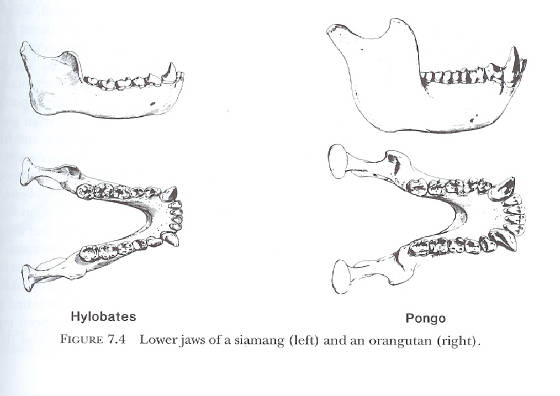|
Click here for genus info
Unlike the Cercopithecoidea, Hominoids lack bilophodont molars. Hominoid cheek teeth are much more rounded. The lower molars
have five cusps surrounding a wide talonid basin (see image below for more detail). The upper molars are quadrate with a
distinct trigon and hypocone. The incisors are broad and canines differ between the Hominoids (as well as the sexual dimorphism).

Hylobatids: This group contains the gibbons. The gibbons lack sexual dimorphism. Their molar teeth have low and rounded
cusps, broad and short incisors, sharp canines, and a honing complex seen in cercopithecoids. Gibbons' diets consist of fruit,
leaves, and invertebrates. Their diets tend to adapt to seasons and the food available at the time.
Pongids:This group contains the great apes (orangutans, gorillas, chimpanzees, bonobos, and humans). Pongids have more
robust canine teeth and broader pre molars than the Hylobates.
Orangutans- These Pongids are VERY sexually dimorphic. Their cheek teeth have thick enamel, flat cusps, and wrinkled
surfaces. Orangutans eat leaves, fruit, shoots, and bark.
Gorilla-These Pongids also exhibit extreme sexual dimorphism. Gorillas have highly developed crests on the molars (because
their diet is heavily based on leaves). They have small incisors and large canines that look like tusks.
Chimpanzees-These primates have broad incisors and cheek teeth with rounded cusps and broader basins. Chimpanzees feed
on fruit, nuts, and leaves.
Bonobos-These are the pygmy chimpanzees. There is no sexual dimorphism in their teeth, but it is present in their body
size. Bonobos eat fruit, pith, leaves, and small animals.
Hominids-Humans have small canines, broad premolars, and reduced third molars. Hominid teeth are similar to that of chimpanzees.
The mandible has a protruding chin.

Information was adapted from, Primate Adaptation and Evolution, Second Edition, by John G. Fleagle. For more information
please see "sources" page.
|

